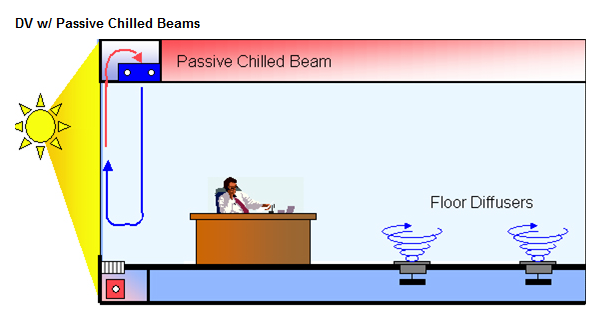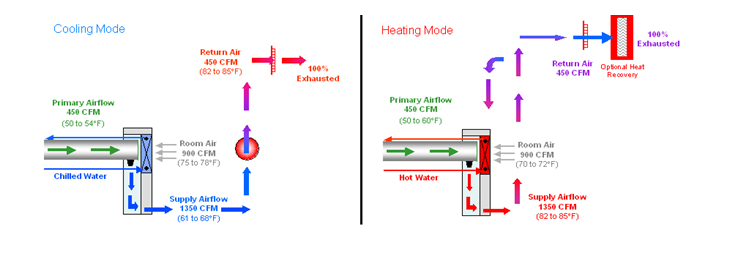Displacement Ventilation (DV)

Ventilation and dehumidification of the space is accomplished by underfloor diffusers served by a central constant volume AHU. The chilled beams should be selected to offset the heat gains associated with the perimeter exposure plus some portion of the occupant, equipment and lighting load. As these beams do not perform during heating operation, a low level hydronic (or electric resistance) heating system is assumed. This combination system (DV with passive beams) will tend to operate like a mixing system once the chilled beams begin to operate at a significant level.
DV w/ Room Induction

Primary air is delivered by a central air handler through the induction nozzles. The velocity of the nozzles induces room air through the integral heat transfer coil which is then cooled in accordance with space thermostat demands prior to mixing with the primary air. The use of room air induction and reconditioning allows the use of 100% outside air as the primary air source. This outside air is cooled to saturation at 50 to 54ºF within the air handling unit, then ducted to the induction terminals. Mixing with the reconditioned room air elevates the temperature of the air mixture to a level which is appropriate for displacement conditioning of the space. The space thermostat regulates the amount of induced air reconditioning in accordance with the room cooling requirements, resulting in a constant volume, variable temperature (61 to 68ºF) discharge to the room. During the heating mode, discharge air is warmer than room air and thus rises to create an air curtain along the perimeter windows. Only the minimum amount of terminals required to satisfy the space heating load should be fitted with four pipe coils. This way a maximum amount of supply air will continue to discharge in a displacement fashion. In heating mode the system operates much like a mixing ventilation system; however, this is not necessary bad from an energy standpoint, since a greater proportion of the internal loads stay in the “occupied” layer and thus offset more of the space heating load.